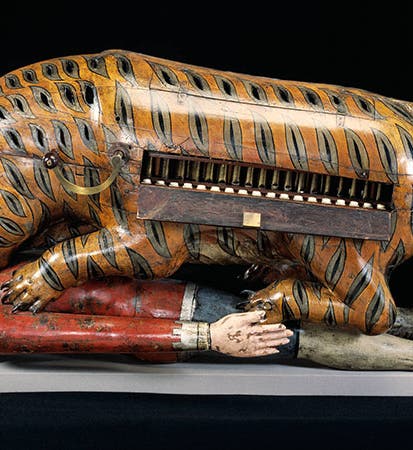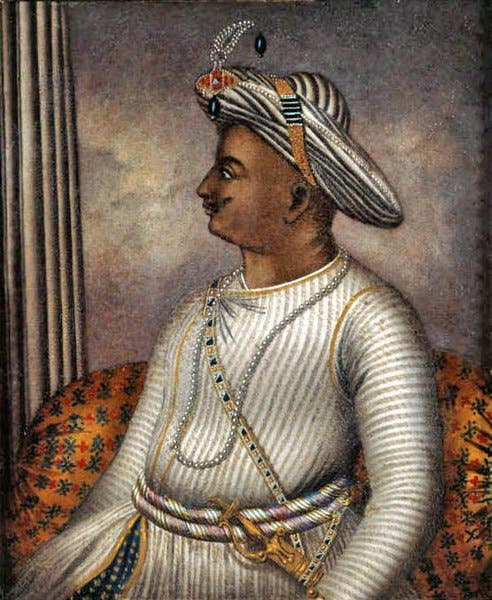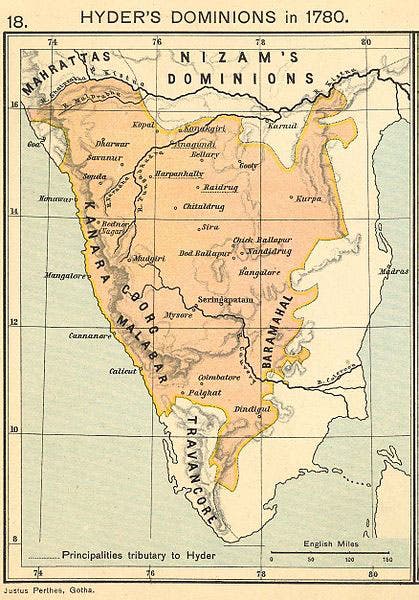Scientist of the Day - Tipu Sultan
Tipu Sultan, the "Tiger of Mysore," was born Nov. 20, 1750. Tipu became the ruler of Mysore in southern India in 1782, succeeding his father, Hyder Ali. The extent of Tipu’s inherited kingdom is shown in a map (fourth image). Mysore was in the midst of a war with the British East India Company, a war known as the second Mysore War. Although no one really won this war – a treaty was signed in 1784 to end the stalemate – Tipu certainly developed a pronounced hatred for the British. Evidence of his antipathy is a mechanism that he commissioned around 1795, a life-size mechanical tiger, carved from wood and gaudily painted. The tiger sprawls upon a prostrate English soldier, with its teeth embedded in the Englishman's neck, and when you turn a crank in the tiger's side, the tiger growls, and the Englishman shrieks, as his arm moves up and down to cover his mouth and modulate his groans (first image). There is also a flip-down panel in the tiger’s side that reveals an array of push buttons that operate a miniature 36-pipe organ that, for reasons known only to Tipu Sultan, was installed in the tiger’s thorax.
It is thought that Tipu got the idea for his manikin-eating tiger from an incident that occurred in 1792. One of Tipu’s many English enemies was General Hector Munro, who had defeated Tipu's forces in a battle during the second Mysore War. Twelve years later, General Munro’s son went on a day-trip with some companions to an Indian coastal island. When they stopped for tea-time, a monstrous tiger sprang from the underbrush and landed on young Munro and proceeded to maul and chew him into a gruesome mess, and the lad died from his wounds a few days later.
The incident was widely reported in British and Indian magazines of the time. One can imagine that the mental image of a tiger gnawing an Englishman to death made an indelible impression on Tipu Sultan, and at some point, it occurred to him that he could re-live his pleasure again and again by recreating tiger and victim in mechanical form. The death of young Munro inspired not only Tipu and his craftsmen, but a Staffordshire potter, who created a macabre ceramic of Munro fils as corpus delectable (third image).
Tipu Sultan was killed in battle during the fourth Mysore war in 1799, and his mechanical tiger was captured as well. Perhaps it even put up some resistance. By 1808, Tipu’s tiger was on display in the Museum of the East India Company, and fifty years later, with the demise of the company, the tiger was transferred to the Victoria and Albert Museum in London, where they insist on calling it “Tippoo’s tiger”. It has enthralled viewers ever since it moved in.
The death of Tipu inspired quite a few paintings; we show you one by Henry Singleton, painted ca 1800, that was auctioned in 2005 by Sotheby’s for a tidy sum (fifth image). We do not know its present-day whereabouts. Dr. William B. Ashworth, Jr., Consultant for the History of Science, Linda Hall Library and Associate Professor emeritus, Department of History, University of Missouri-Kansas City. Comments or corrections are welcome; please direct to ashworthw@umkc.edu.










